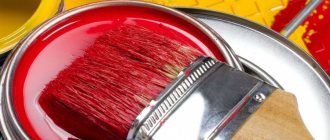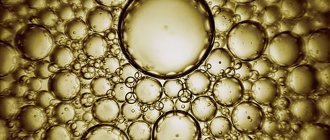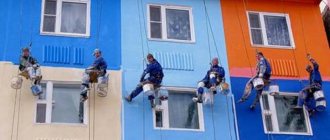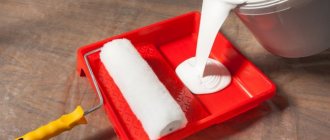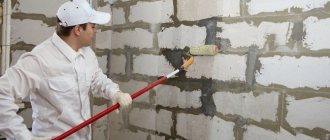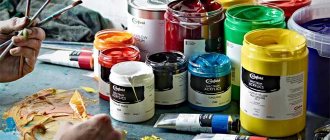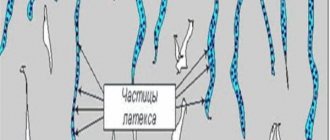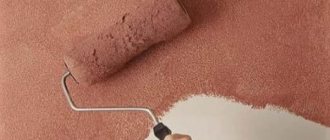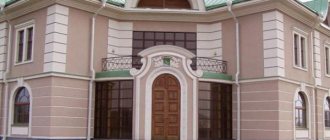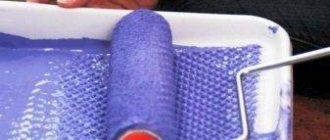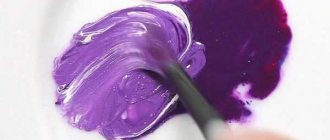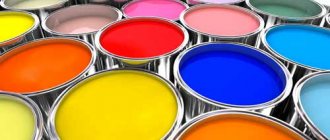The main differences between water-based and water-dispersion paints
Water-based paints are popular modern materials used in everyday life, construction and repair, as well as in various industrial fields: from mechanical engineering to printing.
Aqueous compositions are environmentally friendly and non-flammable. They are easy to apply, dry quickly and form a durable surface layer. There are water-based and water-dispersion dyes.
Water-based materials are a “liquid in liquid” dispersion system. The composition contains two immiscible liquid components: water and an oily substance. The basis of water-based dispersion paint are synthetic polymers and resins that form phases with water that do not chemically react with each other.
Differences in paints
The main similarity between both paints is the presence of water in the composition. But they have a set of differences that need to be taken into account before choosing. This will affect their performance.
Among the differences:
- Moisture resistance. Water-dispersed ones have good resistance to humid environments. But their opponent is easily removed with water, which makes it unsuitable for rooms with high humidity;
- Covering power. The water-imulsion type is capable of perfectly covering the color of the surface to which it is applied;
- Price. Water-dispersed ones cost much less than their competitor;
- Dilution. It is better to dilute the water-based emulsion with a solvent. For his opponent, you can use regular water.
The main similarity between both paints is the presence of water in the composition.
Properties of water dispersion paint
In addition to water, dyes include fillers, pigments, binding polymers and substances that give the material additional properties. Aqueous dispersions are often sold in the form of a liquid paste, which is diluted with water immediately before use. It is recommended to dilute aqueous emulsions with oily solvents: drying oil or turpentine.
Main components
Water-based paints contain materials that determine their performance and performance characteristics. These include the following components:
- Fillers - tiny marble chips, talc or powdered chalk. These components are responsible for the hardness, wear resistance and other performance properties of the coating.
- Pigments - determine colors and shades.
- Binders and film formers are polymers that hold all components together and create a surface layer of paint after the water evaporates.
- Solvents: water - for an aqueous dispersion system, water and oil - for a water-based dye.
- Complementary components are substances that provide the necessary performance properties and improve the technical characteristics of the coating.
Depending on the additional additives, aqueous dispersions based on polyvinyl acetate, latex and acrylic are distinguished.
Paints containing PVA adhere perfectly to plastered surfaces, wood and concrete. They are inexpensive, easy to apply and dry quickly, but are not suitable for outdoor use and rooms with high humidity, as they are poorly resistant to dirt and weathering. Polyvinyl acetate dyes are perfect for finishing walls and ceilings indoors with moderate humidity.
Latex coating is more resistant to moisture and abrasion, is not afraid of contamination and can be used for painting kitchens and bathrooms.
Acrylic dyes have the best protective properties and resistance to external influences. They are not afraid of moisture and dirt. Acrylic compositions can be used indoors with high humidity and for painting external walls made of wood, brick and concrete.
Specifications
In addition to the composition, which largely determines the performance properties of the paint layer, the main characteristics of water-based paints are:
- viscosity;
- consumption to cover one square meter;
- temperature conditions during storage and application of paint;
- drying speed.
Viscosity determines the fluidity of a material and depends on the concentration of water. The viscosity of the dye for application with a brush or roller should be about 40-45 St, and for a spray gun - about 20 St.
Material consumption per square meter determines the ability to completely paint the surface in one layer. Aqueous dispersions have good hiding power, so on average from 170 to 220 ml are consumed per square meter. The indicator depends on the viscosity and characteristics of the surface being painted.
Water-based paints should not be frozen or used at sub-zero temperatures. It is undesirable to work with the material at temperatures below five degrees Celsius and at high air humidity.
Water-based dyes dry quickly. After 30-45 minutes the surface layer is no longer sticky, and after 8-12 hours the coating is completely dry.
Paint consumption
The consumption of water-based paint largely depends on the diameter of the polymer particles in it. If they:
- Small ones. The composition is easy to apply, but does not spread well. Traces remain. This property of paint is called thixotropy - rapid liquefaction under mechanical action (for example, with a brush) and equally rapid thickening at rest.
- Large ones. Paint with these spreads excessively. What remains are not seals, but smudges.
In the first case, accordingly, the paint consumption is greater. In the second case, the composition is spent to a minimum. But, you have to solve problems in the form of clots and leaks, or put up with them. Therefore, it is advisable to choose the golden mean - a water-based emulsion with polymer particles of medium diameter.
Applying paint to a wall with a roller
The size of filler particles in paint has a lesser effect on its rheological (deformation) properties. The viscosity of the paint is controlled by water-soluble thickeners. Their proportionality can also affect the flow rate along with the diameter of the polymer particles.
Affects paint consumption and composition:
— The highest indicator is for latex. The first layer requires 0.6 kilos per square meter. The second layer takes 0.4 kilograms.
— If the paint is polyvinyl acetate, the square requires 0.55 kilos for the initial application and 0.35 for the secondary application.
— Silicate water-based emulsions are average. The first layer requires 0.4 kilos. The second layer takes 50 grams less.
— Consumption of silicone compounds is 0.3 kilos for the first layer and 0.15 for each square of the second layer.
— The most economical is acrylic paint. There the ratio is 0.25 to 0.15 kilograms per square meter.
The paint consumption is partially affected by the base on which it is applied. If the material is porous or uneven, more water-based emulsion will be lost. The paint is absorbed into the pores of the base, fills the cracks in it, that is, at the same time it acts as a primer. Therefore, it is also recommended to use primer in order to reduce emulsion consumption.
It is due to partial absorption into the base that the first layer of paint always takes more than the second. The number of layers required for high-quality painting depends on the covering power of the water-based emulsion. The term refers to the degree to which the paint pigment covers the color of the substrate being coated. Some water-based emulsions need to be applied in 1 layer, while others need 3-4.
The following factors also affect paint consumption:
- Tool used. With a brush, for example, the consumption is less than with a roller. Rollers with long pile absorb especially much.
- Temperature during work. At low temperatures, the water in the paint sets, and at high temperatures, it evaporates too quickly. Hence the higher consumption. The ideal temperature is about 20-25 degrees.
- Humidity of surfaces and air during painting. In dry rooms, water evaporates from paint faster. Accordingly, the emulsion consumption increases.
- Application technology. Manual application, for example, requires more water-based emulsion than when spraying it from a spray gun.
An abundance of factors makes it difficult to accurately calculate paint consumption without proper skill. Therefore, it is recommended to take a little more than what is obtained according to the formula.
Differences between waterborne paints
The different composition determines the differences in the performance properties of water-dispersion paint and water-based paint. Differences in the composition of the components affect the methods of preparation for working with dyes, the conditions for their application and areas of application.
Main differences:
- Water-based paints are easily washed off with water. Water dispersions have greater moisture resistance and can be used for interior and exterior use.
- Water-based dyes are produced in a wide variety of colors and shades, and dispersion dyes are produced in white. To give the required shade to aqueous dispersions, special dyes based on synthetic resins, universal pigment concentrates and color pastes are used.
- Aqueous dispersion dyes and pastes are diluted with water before use, and water-based dyes are diluted with organic oily solvents.
Main differences or what is the difference
Having considered all the characteristics, we can conclude that water-based paints differ from water-dispersion paints. It is worth noting that water is only 1 part by which these compositions can be equated, otherwise there are only differences:
- One of the main things to highlight is the excellent moisture resistance of water-dispersed ones, but water-emulsion ones are very easy to wash off with water. It is better not to use it for painting damp rooms.
- Water-based dyes have a good hiding power.
- Water-based dyes are significantly cheaper than the comparable competitor.
- To dilute water-based paint, use plain water; for water-based paint, it is better to use a solvent, such as white spirit.
- Water-dispersed is often produced in white and use color to add color.
Our expert advises reading this:
- Choosing a yacht varnish for woodworking Initially intended as an external and internal impregnation of wooden ship hulls, yacht varnish has now become actively used in…
- How to get red by mixing paints Everyone knows that by combining 3 primary colors (red, yellow and blue), you can achieve any other color. This theory is still in...
- Polyvinyl acetate water-based paints - characteristics and composition Preparing for alterations in the apartment, we come to the problem of selecting paint, thanks to which our design thoughts will come to life. She should fit...
Advantages of acrylic dispersions
Aqueous dispersion dyes with acrylic-based binders are widely used due to their versatility and high performance characteristics.
The main advantages of water-dispersed acrylic paint:
- Dyes create elastic coatings that smooth out unevenness and bridge microcracks.
- They tolerate ultraviolet radiation well and do not fade for a long time under the influence of direct sunlight.
- They have high strength and water-repellent characteristics.
- Capable of allowing air and water vapor to pass through and “breathe”.
- Excellent tinting using various coloring systems. More than 10 thousand colors and shades of acrylic paints are known.
This paint has other advantages:
- High temperature resistance: paints do not melt or spread at high temperatures. External coatings tolerate heat well, while internal coatings tolerate the proximity of heating devices.
- Frost resistance. The paint layer retains its integrity and performance properties in frost conditions of -30˚C.
- Long service life: the coating maintains its quality for 10 years.
The only relative disadvantage of water-based acrylic paints is their higher price than dispersion compositions based on other binders.
Recently, many types of paints have appeared on the paint market. And for those who don’t know, sooner or later the question will arise what is the difference between acrylic and water-dispersed paint.
Water-dispersed paints are paints that are produced on the basis of water-dispersed polymers. Vinyl acetate, acrylic polymers and their various derivatives, etc. are used as polymers for this type of paint.
Of course, it should be noted that there are also water-emulsion paints on the market of paints and varnishes. These paints are mainly produced based on water-based polymer emulsions. Examples of such paints can be called alkyd VE paints. And recently, our market has seen an increase in water-dispersion and water-emulsion paints and varnishes.
Acrylic paints are the same water-dispersed paints that are produced on the basis of polyacrylates (mainly polymers of methyl, ethyl and butyl acrylates) and their copolymers as film formers.
Reasons for using acrylic paints
Acrylic paints are used mainly for repair work on construction work, both for external and internal work. Plus, these paints are actively used by artists in painting. These paints are diluted with ordinary water according to the same principle as water-dispersed paints. Also, in the process of diluting this paint, it can be tinted with aqueous pigment pastes of various colors, which, after drying, become resistant to water.
Any acrylic paints, after they are completely dry, become darker than they were before being applied to the surface to be painted. The drying process of such paints dry quite quickly. And this is a significant advantage of acrylic paints over other types of paints. They can be applied both in liquid and paste form, which is quite convenient for various types of tasks that artists face.
Acrylic paints, unlike other paints, can be safely used on absolutely any surface that has a non-greasy base. It can be: glass, wood, linen, metal, canvas and more. This paint can be removed with ordinary water, but provided that it is still fresh and not 100% dry. And if the paint has dried, it can only be removed with the help of special solvents.
Reasons for using waterborne paints
These types of paints do not contain, and if they do, there are very few highly volatile organic solvents. As a result, such paints have a low level of toxicity.
It is very easy to apply such paints to the surface; they dry quickly and are resistant to ultraviolet sunlight. These paints differ from others in their high adhesion to many types of different surfaces. These paints are durable and have such good quality as vapor permeability.
Sabibon - the most interesting things on the Internet
Did you like the post? Click Like
Acrylic paint
It is an improved version of the water-based one. The composition of the paint and varnish material includes the following components: distilled water, polymer acrylic emulsion, dye. Polyacrylics with copolymers contained in the paint form a special protective film on the surface being painted. The paint and varnish composition is superior to other types in quality and durability. After painting, the base acquires an expressive and rich color that does not fade under the influence of ultraviolet rays and is not washed off due to high humidity. The water base ensures no odor after drying. To obtain a bright shade, the paint is applied in several layers. Acrylic paints are suitable for artistic painting. They are used in the design of design elements and the creation of original interiors. The composition can be diluted with water. To obtain a paste, the paint is diluted with a special compound. Paint and varnish material is often used for painting artistic paintings.
Advantages
Acrylic paint has many advantages, thanks to which it is widely used for painting various surfaces:
- the composition hardens in half an hour, and dries completely after a few days and much faster if the air temperature is high;
- the coating gives the surface a beautiful appearance, resistant to fading and washing off, which guarantees a long service life;
- the presence of a protective film, which provides not only durability, but also prevents rolling and cracking;
- the versatility of the paint allows the use of compositions for coloring, painting, and creating artistic canvases;
- the absence of toxic substances makes the material absolutely environmentally friendly;
- a variety of colors allows you to choose a color or shade for absolutely any interior;
- the absence of combustible and flammable components makes the paint fireproof.
The simplicity and ease of application of acrylic paints allows even an inexperienced person to paint. There is no need to involve a specialist in such work.
Basic properties
The water-dispersed base is the main advantage of the finishing material. The optimized composition of the paint and its unique components allow you to process any textured interior item and paint the surface of stone, wood, brick, concrete, as well as plastered walls. Due to the high-quality dispersion of pigment components, the most significant defects are masked. In addition, the high wear resistance of VD AK paint is higher than that of other enamels.
Important! Some water-based paints require the use of a primer. Such primary treatment is also required when repainting interior items or facades.
Specifications
Water-based compositions are distinguished by the following features and properties:
- consumption - 150-200 ml/m² is consumed for 1 layer, the second layer is required depending on the absorbent properties and density of the material being painted;
- viscosity - determines the degree of dilution of the composition, should be 40-45 s, when using a special sprayer - 20-25;
- specific gravity – 1.3 kg/l;
- drying time - up to a day, depending on the humidity in the room and temperature, most brands have a high drying speed;
- shelf life – 12 months in a tightly closed container at a temperature of +5°C;
- fire hazard class – KM0-KM1.
Optimal conditions for drying are humidity 65%, temperature +20°C.
Popular products
There are several types of VDAK paints, each of which has its own unique properties and purpose. General description of the most popular products:
- Paint VD AK-1180. Used as a base for initial and secondary coatings. Weather-resistant, moisture-resistant, covers a wide color spectrum. VD AK-1180 paint is popular in the construction of large industrial facilities.
- Paint VD AK-111. Thanks to its unique composition with a latex base, the paint becomes more resistant to mechanical stress and natural factors.
- Paint VD AK-101. The material is suitable for painting surfaces of any type. This paint dries quickly and is completely environmentally friendly, which allows it to be used for interior work.
The most popular paint for exterior work is VGT VD AK-1180 enamel. The material is intended for painting concrete, wooden and plastered walls; it has high water and weather resistance. VGT 1180 facade paint is excellent value for money.
Water-dispersion paints VD AK of other types are used less often or have a narrow profile with limited application properties, for example, painting floors, painting wooden structures, etc. Below we will consider in more detail the technical characteristics of the different options.
On video: features of water-based paints.
Varieties
Acrylic paints are universal because they are available in several versions, each of which has its own purpose:
- Washable. Withstands from 1500 to 3000 wet cleaning cycles. Contains latex to resist moisture. Great for use in kitchens, bathrooms and kitchens.
- Atmospheric. Designed specifically for exterior painting work, they are characterized by increased resistance to external negative weather phenomena, including precipitation, high and low temperatures.
- Internal. Designed for interior decoration. They are characterized by high service life and abrasion resistance.
- Facade. Used for painting building facades. They are an excellent alternative to more expensive siding.
The choice of variety is directly determined by what surfaces are planned to be painted. This ensures the durability and reliability of the painted surface.
Characteristics of different series
Depending on the series, the main scope of application of such paint and varnish products is determined. There is a difference between VD façade paint and universal enamel for interior painting. However, both have acrylate properties, which increases their functionality.
Specifications:
- Paint VD AK-1180. Almost universal in its application, it is used for painting metal, concrete and wooden surfaces. A huge plus is that VD AK-1180 paint does not contain heavy chemical compounds. The enamel is applied at a temperature not lower than +5 and not higher than +35 degrees.
- Paint VD AK-111. Ideal for interior and exterior finishing, it is weatherproof and waterproof, which extends the service life of the coating to five years. However, water-dispersion paint VD AK-111 cannot be used for painting floors, since it quickly wears out under intense loads and friction.
- Paint VD AK-2180. This is an interior finishing material that is suitable for painting walls and ceilings in rooms with moderate humidity. Also, acrylic paint VD AK-2180 is ideal for painting wallpaper.
- Paint VD AK-101. Designed for painting building facades and internal load-bearing structures made of plasterboard, chipboard, fiberboard, non-toxic, forms a special weather-resistant layer that protects the surface from mechanical damage. Another advantage of VD AK-101 paint is that it retains an aesthetically attractive appearance for at least eight years.
- Paint VD AK-449. Used exclusively for painting floors and some other wood surfaces. It has a pleasant color, is fireproof, odorless, and creates a wear-resistant and durable coating. Eliminates rapid wear.
- VD AK-114. This is a matte aqua enamel, which is applicable in atmospheric conditions and for interior decoration. Ideal for wet rooms (bathrooms, kitchens, swimming pools), for walls and ceilings in children's and medical institutions. There is a huge range of colors.
In addition to paints, VD AK-0301 primer is often used. It is ideally combined with any of the enamels of the presented series, and is intended for treating walls indoors and outdoors (before painting, puttying walls, installing ceramic tiles). The primer is stable, lays down in an even layer and completely fills porous, defective areas.
Review of water-dispersion paints (2 videos)
Water-based paints of different brands (30 photos)
In this article we will talk about which paint is better - water-based or water-dispersion and what are the characteristic differences between these two compositions. In fact, these are different paints and varnishes.
Despite the fact that both coatings, to one degree or another, consist of water.
In order to understand the difference between water-based paint and water-dispersion paint, you need to pay attention to the technical characteristics of paintwork materials.
Wide range of colors for water-based compositions
Among them we especially note:
- compound;
- viscosity;
- consumption per square meter;
- specific gravity;
- shelf life and optimal storage conditions;
- operational features.
Which paint to choose?
Having considered all the differences between water-dispersion paint and water-based paint, we can conclude that they differ from each other, not only in price and composition, but also in performance characteristics. Expert advice:
- If you need to make inexpensive repairs or paint only elements in the interior, then it is better to use a water-based composition.
- If paint is the only coating on the walls and the repair is designed to last for a long time, then it is better to choose a water-dispersed dye.
- A water-dispersed composition is suitable for expressing creative ideas and design aspects.
- Compositions with silicone resins are recommended for swimming pools, saunas, and bathrooms. They are not only moisture resistant, but also not susceptible to fungus formation.
- Despite the volume and complexity of the work, give preference to proven brands. Good quality is the key to success.
Water-based paints
The most popular tool for applying water-based and water-dispersion paint
This category of paints and varnishes is presented in a wide range on the domestic market and is in obvious demand.
And this is not surprising, since water-based compositions have the following advantages:
- quick drying (several hours on average);
- environmental cleanliness and safety and, as a result, no need to use personal safety equipment when carrying out finishing work;
- absence of a specific pungent odor characteristic of most traditional enamels.
- the ability to give the coating a particular color by adding special pigments.
- simple instructions for applying paintwork and the availability of tools necessary to perform painting work;
- affordable price.
Important: Water-based coatings have some disadvantages. Among them is carrying out painting work at a temperature of at least +5° C.
Main characteristics
The photo shows the use of water-based paints and varnishes as a coating for decorative plaster
- The composition of water-based paints includes components such as filler, latex, thickener and antiseptic additives.
- Viscosity determines how much the dye mixture is diluted with water. To measure this parameter, a special instrument is used - a viscometer. On average, viscosity should not exceed 45 Art.
Important: If you use a spray gun rather than a paint brush to apply paint compositions, the viscosity parameters should not exceed 20-25 Art.
- The consumption of water-based paints when applied in one layer is, on average, 200 ml per square meter. However, consumption is largely determined not only by the characteristics of the coating, but also by the absorbency of the base.
- The specific gravity of coating materials does not exceed 1.40 kg/l.
- Drying times depend on air humidity and room temperature. Depending on the brand of paintwork, drying can last from 2 hours to a day. The optimal temperature during painting work is considered to be +20° C with a humidity of no more than 65%.
Types of water-based paints
The photo shows a water-based composition with the addition of latex.
The difference between water-based and water-dispersion paint lies in the difference in composition.
In accordance with the composition, the following types of water-based coatings are distinguished:
- acrylic;
- mineral;
- silicate;
- silicone.
Acrylic compositions are the most common and in demand. The main component in this case is acrylic resins. To increase the hydrophobicity of the coating, latex is added to the paintwork material.
Important: Acrylic water emulsion with latex filler, when laid in two layers, fills and masks cracks up to 2 mm wide.
Acrylic coating works equally well on wood, brickwork, concrete, plaster, glass and metal. A typical example is fire-retardant paints for metal Polistil. These coatings, despite their specific purpose, are universal and can be applied to any pre-primed surface. (See also the article How to putty walls: features.)
Mineral water-based coatings contain cement or slaked lime. Such paints and varnishes are used for application to most different surfaces. The disadvantages of these compositions include their short service life.
Water-emulsion silicate materials are a mixture of liquid glass, an aqueous solution and pigments. Such coatings are characterized by a high degree of vapor permeability, as well as resistance to precipitation and temperature changes. On average, the service life of a properly applied coating is about 20 years.
Silicone water-based paints use silicone resins as a binding component. Such compositions are an order of magnitude more expensive than their analogues, but are also distinguished by their high strength and durability.
Water based paints
Materials based on distilled water are intended for both internal and external use. They contain additional binding components that determine the layer’s resistance to external (mechanical, temperature or atmospheric) influences. For application, use brushes, rollers (with coats made of any material), as well as sprayers. The painting method is chosen depending on the area and orientation of the surfaces in space.
The advantage of water-based paints is their environmental safety.
Emulsion dyes
Emulsion materials are a suspension of pigment and additional components in water; after the moisture evaporates, they form a durable protective layer (resistant to precipitation and washing). Use warm water to remove fresh paint from tools or clothing. The compositions are characterized by increased environmental friendliness (when applied and dried, no substances harmful to humans are released into the air). The coating has microscopic pores that allow moisture to be removed from the base.
Acrylic paints
The materials are based on acrylic resins and have increased elasticity. The coating allows you to cover cracks up to 0.5 mm wide, does not collapse and does not lose color when exposed to ultraviolet radiation. Acrylic enamels protect the base from the penetration of water from the outside (for example, they are used for structures with reinforcing mesh or rods). Paints and varnishes have high adhesion (when applied to a dry surface) and are resistant to external mechanical influences.
Textured plasters
The group includes textured plasters containing admixtures of granite or other minerals. After the moisture evaporates, a decorative layer with a rough surface remains on the surfaces; the pigments introduced into the composition make it possible to imitate natural finishing materials. Plaster allows you to seal uneven areas and cracks in walls or ceilings.
Polyvinyl acetate
Emulsion-type enamels containing polyvinyl acetate (PVA), pigments and additives to stabilize and impart elasticity to the coating. The industry offers ready-to-use materials and paints made from 2 components (plasticizer and pigment), which must be mixed before application. It takes 2-3 hours for the moisture to evaporate; a semi-matte, uniform film is formed on the painted surfaces, resistant to base deformation and condensation.
Latex dyes
The materials include a suspension of synthetic latex (on an acrylic, urethane, polyvinyl acetate, siloxane or styrene-butadiene base), which forms an elastic film together with pigments. The coating follows the contours of the surfaces and withstands external loads. The layer is permeable to air, is not destroyed by cold and hot water, and does not lose pigmentation under the influence of ultraviolet radiation or chemical reagents (for example, detergents).
Latex paint is characterized by increased wear resistance.
Silicone dyes
The binder is silicate resins; the resulting coating is not washed away by water, but allows air to pass through. The layer is highly elastic; cracks up to 2 mm wide can be painted over without filling with putty. The paints are designed for application to plaster 2 days after finishing; the material has antibacterial properties and can be cleaned with both water and special chemicals.
Mineral compositions
Materials based on crushed minerals are intended for finishing facades made of brick, concrete, or used during restoration or repair work. Paints are often dry (in powder form), which are diluted to the required consistency with water. After hardening, the layer allows evaporation to pass through, allowing excess moisture to be removed, extending the life of building facades. To change the characteristics (for example, adhesion to the base or plasticity), synthetic resins are introduced into the composition.
Mineral compositions are divided into categories on a basic basis:
- lime (based on slaked lime) with inorganic dyes of light shades;
- cement (with the addition of Portland cement), contain slaked lime and calcium chloride;
- silicate, consisting of alkali-resistant pigments and filler;
- oil, consisting of a mixture of pigments and drying oil with the addition of a drier and additives that reduce the likelihood of sediment formation.
Water-dispersion paints
The photo shows water-dispersion paint
As already mentioned, the main difference between water-based paint and water-based paint is the composition. Water-dispersed coatings are made on the basis of polymers and water dispersions. The binder components are acrylic and vinyl acetate polymers.
Currently, the share of water-dispersed compositions on the coatings market is about 60% and this figure is increasing every year.
Features of water-dispersion paints
The photo shows the consistency of paints and varnishes
Water-dispersed coatings are characterized by:
- absence of organic volatile solvents;
- simplicity and accessibility of application methods;
- quick drying (on average, it takes no more than 30 minutes to dry one layer);
- resistance of paints to ultraviolet radiation;
- high adhesion to various types of surfaces, including previously painted coatings;
- good vapor permeability;
- durability (up to 20 years with proper preparation of the base).
Zinga electrically conductive paint ensures longer service life
There are also disadvantages, including:
- application at a temperature not lower than +5° C;
- the need for high-quality preparation of the working base;
- high price compared to its water-based counterpart.
Paint and emulsion
An emulsion is a mixture that consists of water and fatty substances that are insoluble in water. In order to facilitate the process of forming a mixture of this kind, water-insoluble substances, that is, the polymers that make up the paint, undergo preliminary preparation before emulsification. It consists of adding any organic solvents or alcohols/acids. That is, in essence, water-based paint is two immiscible liquids, or so-called “phases”, while one of them is “external”, due to the fact that it contains the other, “internal”, which is distributed in it in as microscopic droplets.
Thus, in order to bring water-based paint to a more liquid consistency (which may be necessary when using a spray bottle to apply it or in case of thickening), you will need an organic solvent called white spirit (from English “white alcohol”), also called Stoddard's solvent.
Conclusion
So, we figured out whether there is a difference between water-based and water-dispersion paint and how significant it is. Despite the fact that both paint and varnish materials are made using water, there is a difference. First of all, this is the price and coverage indicators.
For example, water-based coating demonstrates better hiding power. This is important when applying it yourself. But the price of such compositions is an order of magnitude higher than the cost of water-dispersed analogues. The choice of these, largely similar, but at the same time different paintwork materials should be made based on the parameters of the base and the operating conditions of the finished coating.
You can find more useful information on this topic by watching the video in this article.
Popular posts
- Silicone sanitary sealant Silicone sanitary sealant white in Moscow - 1491 products Company from Moscow, delivery (tomorrow) 140...
- Shelf in the hallway Currently, there are a huge number of different options for shelves in the hallway, and this is directly ...
- Insulation of the floor in a wooden Insulation of the floor in a wooden house from below: materials and installation technology SHARE ON SOCIAL NETWORKS One of the common…
- Chair for dressing table Chairs for dressing tables in Moscow - 189 Products Company from Moscow, delivery 29643 a In…
The difference between an emulsion and a dispersion
Having understood the differences between water-based paint and water-dispersion paint in terms of composition and properties, we can present the distinctive characteristics in the form of a table.
| Water emulsion | Water dispersion |
| Polymer particles are completely dissolved in the liquid. | The composition contains small polymers. |
| Has low resistance to mechanical stress. | It has a high level of mechanical resistance. |
| Belongs to the middle price category. | Refers to budget-priced products. |
| Wash off with water. | Has a high level of moisture resistance. |
| Available in a large number of shades with the possibility of independent tinting. | Supplied in an exceptional white color but can also be tinted. |
Despite the fact that drying speed, environmental friendliness, and ease of use are properties that both water-based and water-dispersion paints have, the difference in operational parameters is significant, which is important to consider when choosing paint materials.
Properties
The qualities of the water-dispersion material depend on the dispersion copolymer, one of the 5 listed in the “Composition” paragraph:
- polyvinyl acetate;
- butadiene styrene;
- styrene acrylate;
- acrylate;
- versatata.
Let us consider one by one the properties of water-based paints containing one of them as a base:
- yellowing, lack of resistance to water, for this reason a narrow scope of application - only in rooms with a normal level of humidity, on surfaces that do not require wet cleaning, and are not subject to mechanical stress;
- good water resistance, but susceptible to UV radiation, application is slightly wider, but still limited to indoor surfaces;
- porosity of the coating, forming vapor permeability, resistance to fading in light, tight adhesion to many surfaces - high adhesion, as a result of wider application on internal and some external surfaces;
- the highest resistance to light, all the advantages have been improved and allow the active use of this type of acrylic water-dispersion paint in unprotected conditions of the natural environment - on the street, that is, in exterior decoration (facades made of different materials - wood, plaster);
- excellent quality characteristics comparable to all the advantages of the listed acrylic paints.
Latex acrylic paints, created on the basis of synthetic rubber - styrene butadiene, with silicone additives, have a number of advantages:
- water resistance – form a washable surface, suitable for use in rooms with high humidity;
- elasticity - will not crack;
- adhesion;
- vapor permeability, but against fungus it is better to use a preliminary primer;
- wear resistance - for rooms with intense loads;
- variety of decorative effects;
- non-flammability.
Like all water-based paints, it is environmentally friendly, as it does not contain toxic organic solvents, dries quickly, and is odorless.
All water-dispersed materials can be tinted, they are easy to work with, and are resistant to alkalis.
What is the paint made of?
The main composition is represented by tiny grains of polymers suspended in an aqueous environment. Depending on the manufacturer, water-based paint may contain a large number of additives - from 10 to 15, namely:
- defoamers that reduce foam formation;
- antifreeze - they prevent freezing;
- thickeners;
- corrosion inhibitors;
- antiseptics;
- plasticizers;
- additives that increase the viscosity of the structure;
- preservatives and so on.
In percentage terms, the composition of water-based paint is as follows: foaming agent dissolved in water 50%, pigments and filler - 37%, plasticizer - 7%, and the remaining percentages include other additives.
